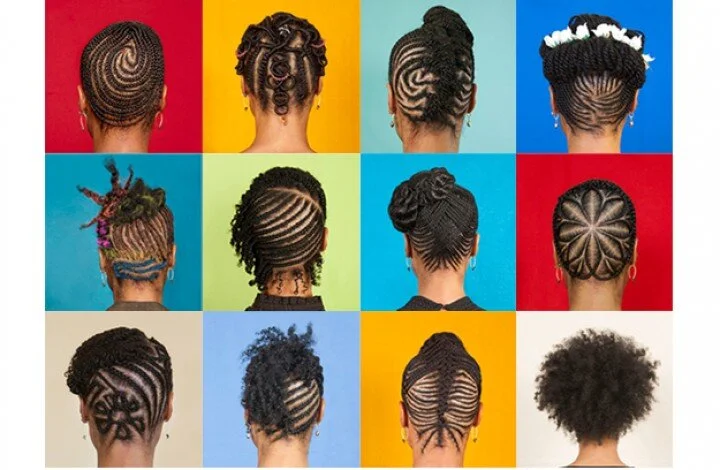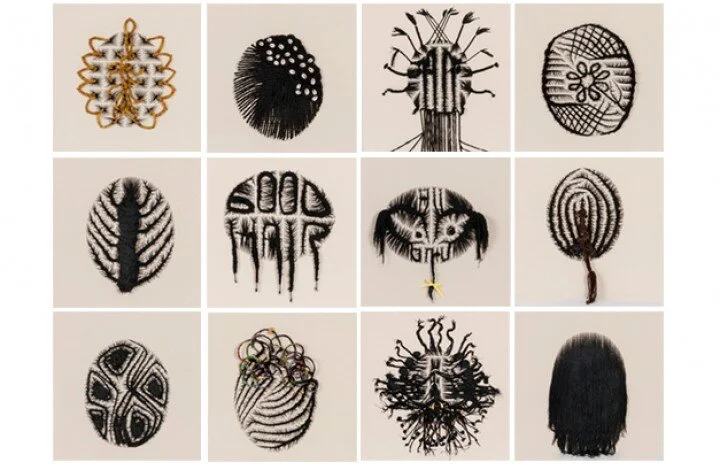Hair
Hair is the only part of the body that is easily malleable, a few intertwined strands or a simple haircut is enough to change face.
It is why throughout the centuries, hair always held very strong symbolism, and that across different civilization and religions. In the Old testament, Delila cuts Samson’s hair to deprive him of all his strength. This story is a perfect example of hair symbolizing strength and virility.
Virility, because for some anthropologists, hair is a sign of sexuality; monks and friars cut their hair down and a sign of abandonment of vanities, but also of chastity. On the other side, hippies, bikers, 'cock rock' heavy metal bands
embrace the untamed and wild aspect of letting their hair as long and as free as possible, because it unconsciously represents a certain sexual freedom. In Islam, women wear a veil as soon as they get their first period, as soon as they become what they call “a woman” that is capable of being a sexual being because now able to procreate. Hair have an undeniable seductive quality part of our bodily apparatus.
In the old days, women would have very long hair that were always tied up in complex and detailed hairdos when in society. Their hair would only be let down in the intimacy of their home and when in the presence of their husband as a way of submitting and revealing themselves to them.
Janine Antoni, Loving Care, 1993
In Loving Care, Janine Antoni mopped the gallery floor with her hair that were soaked in black dye. She did this as direct reference t0 abstract expressionism, such as Jackson Pollock technique of dripping paint onto (massive) canvas that were laid on the floor. And as she was mopping the floor with her hair, visitors were forced to push back until they existed the gallery. That was her way of claiming the space, as the entire floor ended up being covered in dye.
For some reason, this piece can’t help but make me thing of that biblical event, when Maria Magdalena kneeled to the floor to wash the Christ’s feet with her hair. Antoni makes a direct relation to mopping as an action housewives and women across ages spend time doing. And for me Maria Magdalena, uses her hair, an element we established earlier, holds a lot of symbolism and that is place on top of the head, to clean the dirt of the Christ’s feet that is placed at the other end of the body. Loving care is a deeply freeing performance for all woman, kneeling down, mopping up, and hiding their hair away.
It all begins with an idea. Maybe you want to launch a business. Maybe you want to turn a hobby into something more. Or maybe you have a creative project to share with the world. Whatever it is, the way you tell your story online can make all the difference.
Marie Magdalene washing the Christ’s feet with her hair.
Sonya Clark, The hair craft project, 2014
Sonya Clark, The hair craft project canvas, 2014
Sonya Clark is an American artist with Afro-Caribbean origins. In her work, hair is a central element, and a material that goes through a lot of her works. And because like skin, hair is also an indicator of race. Clark uses is as a material to talk about themes such as, identity, gender, race, beauty and heritage.
The care and handling of Black hair is specific, and afro hairdressers are considered like artists, making wonders with one material, hair, and with the use of one tool, a comb.
With only those two things, entire intricate hairdos, with shape and patterns are made.
And because hairdos are and temporary work of art, Clark documents these intricates work in the form of photographs. Erasing the scalp under, we almost feel we are a faced with a woven fabric where we can see, roots, flowers, trees, insects and crops of lands, giving a very poetic dimension to braiding hair and giving all the space for the craft to express itself.
Sonya Clark, Slave collars, 2017
In her Slave Collars series, Clarks attaches hair to a cotton surface. In this piece, hair is used with a lot more tension and violence. The way the hair is attached give an impression of tired and mistreated hair follicle. The cotton surface on the other side feels like a naked scalped scalp, almost as if someone lost hair in the process of something.
This series combines that metaphor of losing “blood, sweat and tears” while working hard for something. In fact, in times of slavery, where black workers would be forcefully working in fields, they most probably did lost some blood sweat tears and hair in the process. The cotton used as a surface is a reference to the cotton filed which used to be a one of the things black people were enslaved in doing.
The Image of teared hair is always a powerful and violent one, hair having this fragile and thin quality.
Helen Pynor, Untitled (uterus urinary), 2010
In Helen Pynor’s case, hair replaces thread, and becomes a knitting material. The interesting thing with hair is that it is only “alive” under the condition that it is still attached to our head and to its follicle (that is only a few millimeters deep). While simply combing our hair, we can lose some, and in this process, from a second to another, a hair goes from being alive (ours), to dead, on the ground.
By using hair as a thread, Pynor knits detailed and delicate sculptures.
She represents alive organism with dead ones, giving life to inanimate hair.
Hair quality can indicate on someone’s health and can sometimes be connected to one’s emotions; hair loss or if turning grey all of a sudden can indicate of stress level or intense fear.
When knitting, Pynor says that the hair has a life and a design of its own because there is only so much she can do. Hair is stubborn and free material that takes the direction that it wants, and it is this free quality that give the deeply organic and alive feel to the sculptures.
Victorian hair wreath
However, hair art is far from being new. This Victorian shadow box containing a hair wreath is the best example of it. Indeed, during the Victorian era, keeping someone’s lock of hair in a locket was common practice.
Moreover, women, at that time, spent most of their days at home, and amongst other manual activities, they would intricately put together these extremely detailed and meticulous wreath as a memorial for the deceased, using their hair.
When first seeing such objects I had a hard time realizing that they were actually made of human hair. The wild quality of the material is completely tamed and tightly “woven” to create tiny flowers and patterns. This gives to the whole piece an equally impressive, beautiful and creepy quality. It also makes me think of outsider art that was so far considered as “inferior”. Looking at the how painstaking this work is the real craft can be denied, as the way they were able to reach such a level of precision is for me still a mystery.
Marina Abramovic and Ulay, Relation in Time, 1977
Kiki Smith, Untitled (hair), 1990
When thinking of the ways humans connect and intertwine physically, we instantly think of two lips pressing against each other, four arms wrapping arounds one another, ten fingers interlacing, or even two sexual organs colliding.
But less obviously, hair can also be a way of binding yourself to your lover, and in Relation in time, it is exactly what Abramovic and Ulay do. They use hair as a visual and physical bind, intertwining their hair into one single and tight ponytail. By doing so, they turn their backs to each other, staring instead the white wall that is in front of them, and so, they end up back to back, and hair to hair. Their hair here is a metaphor for relationship (in time). At first, upright, full of energy and strength, they gradually start to lean forward and hunch their backs as the fatigue slowly take possession of their bodies during this seventeen hours performance. As they start leaning to the front their (hair) connection starts to untie and loosen. The same thing a real relationship can go through when each component that forms the link is each looking in another direction, and especially turning backs to each other.








